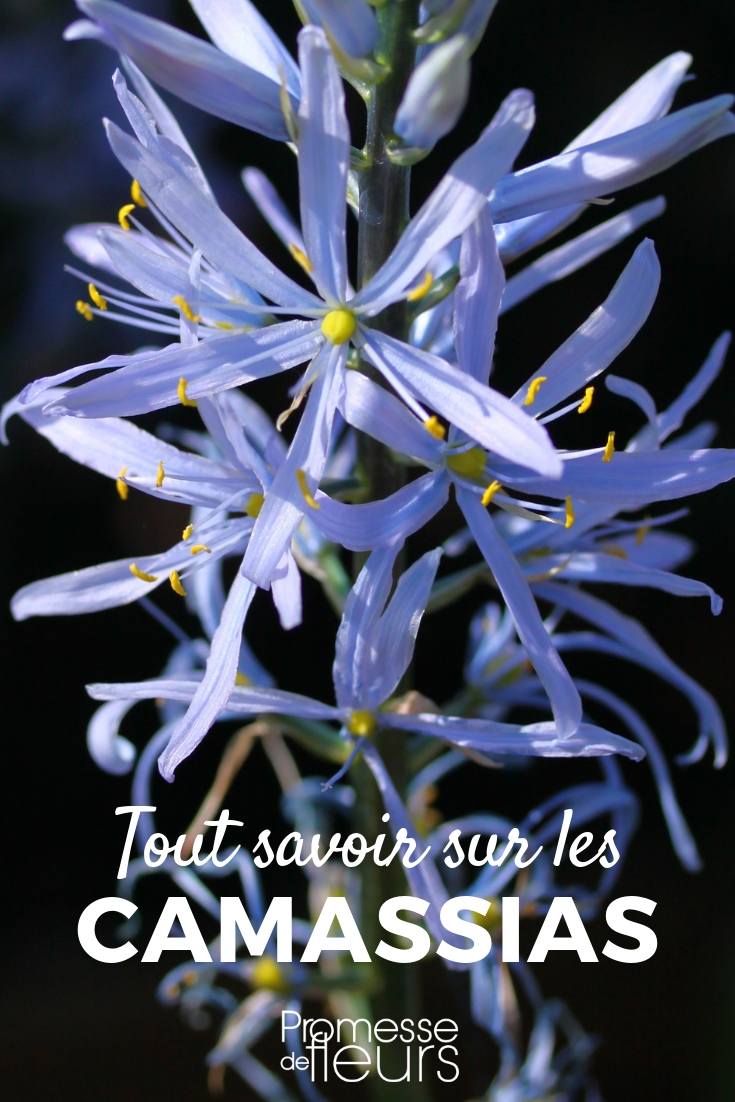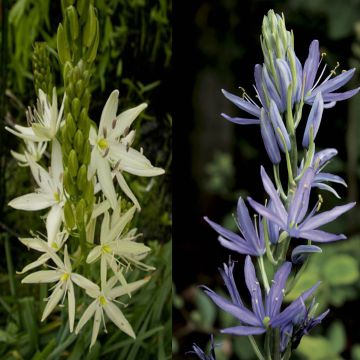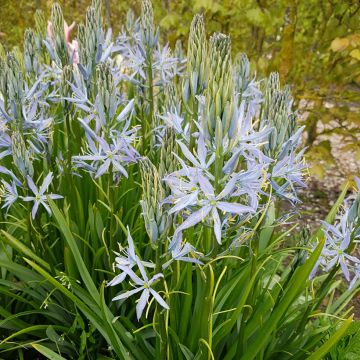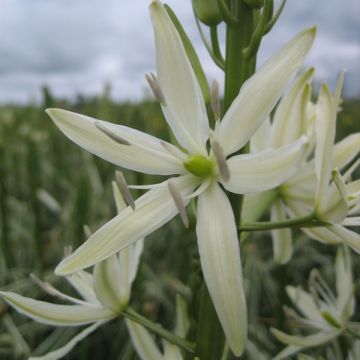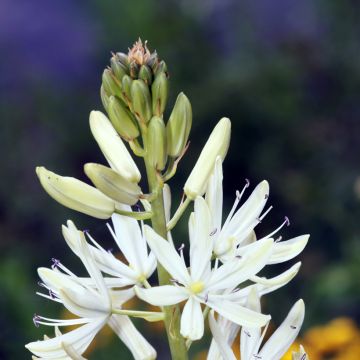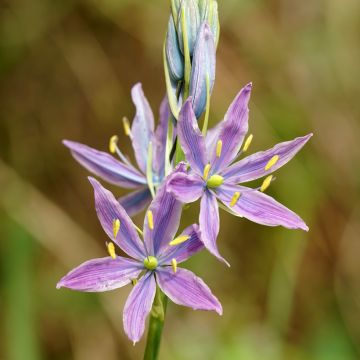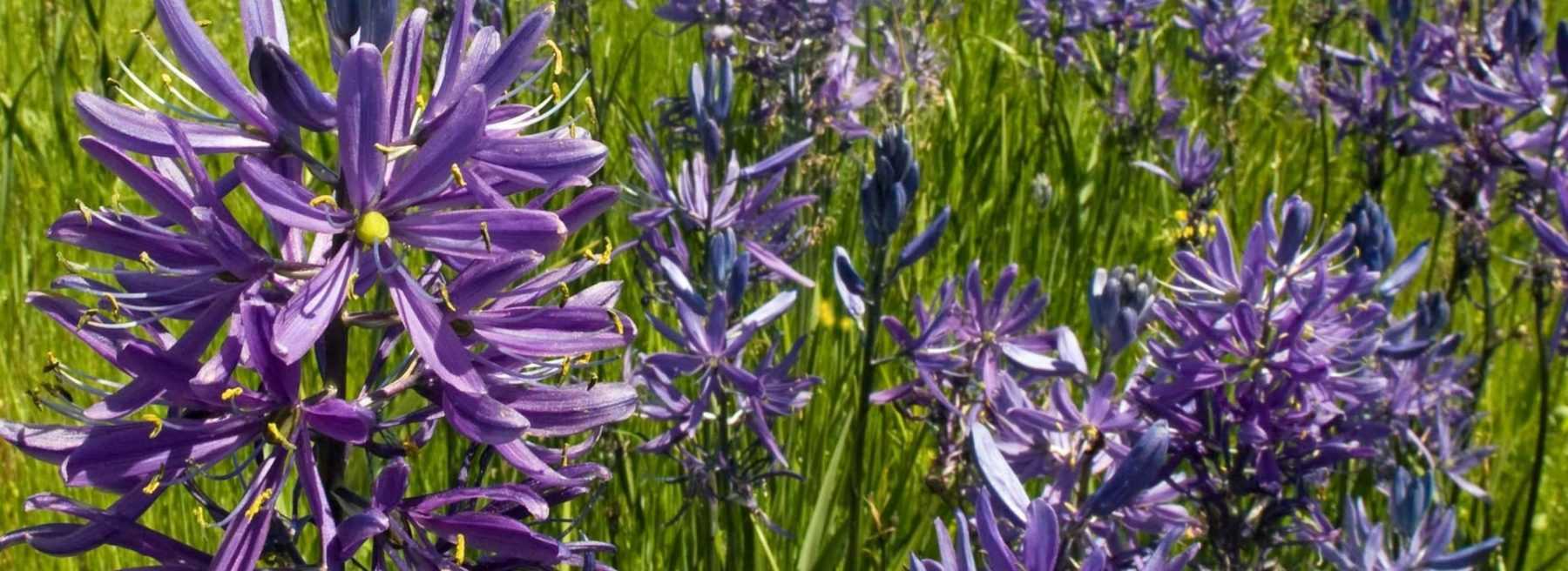
Camassia: Planting, Care and Garden Companions
Contents
The Camassia, in a few words
- Camassia is a bulbous perennial that flowers in spring and naturalises easily. It’s THE perfect tall flowering plant for partial shade and heavy soils.
- It produces tall, sturdy stems adorned with large spikes of numerous star-shaped flowers in blue or white.
- Camassia is easy to grow: very hardy and low-maintenance, it thrives equally well in partial shade or non-scorching sun. It adapts to all soil types, even clay.
- This beautiful yet still underrated bulbous plant finds its place effortlessly in the garden: plant en masse for a flowering meadow effect, in mixed borders with perennials or other spring bulbs, even in pots or by a pond with lush hostas… It also makes superb cut flowers.
- Sometimes called “Quamash”, “Camassie” or “Indian Hyacinth”, it originates from the moist meadows of North America.
Our Expert's Word
The Camassia is a bulbous perennial that unfurls spectacular blue or white flowers each spring, perched atop tall stems. Its inflorescences consist of a multitude of charming star-shaped flowers clustered in spikes.
Camassia is an exceptionally hardy plant. It thrives best in moist, fresh soil. Being undemanding, it adapts to all soil types, even clay ground. Regarding exposure, it particularly enjoys partial shade, but will grow perfectly well in full sun, provided it’s not scorching.
Remarkably resilient, Camassia is the quintessential flowering meadow plant as it naturalises effortlessly. Within a few years it can colonise large areas with a beautifully natural appearance, requiring no gardener intervention.
Camassia features among our favourite perennial plants. Long overlooked, we’re delighted to see it finally gaining recognition. Valued for its sturdiness and elegant bearing, you’ll now frequently encounter it in public parks and urban gardens.
Botany
Botanical data
- Latin name Camassia
- Family Asparagaceae (previously classified in Liliaceae then Hyacinthaceae)
- Common name Indian Hyacinth, Camass, Quamash or Camash
- Flowering Flowering from May to June, numerous star-shaped flowers 5 to 7 cm in diameter, clustered in spikes.
- Height 50 cm to 1.20 m (depending on variety) - Spread
- Exposure partial shade, non-scorching sun
- Soil type all types (even clay), rich, moist to wet, but well-drained
- Hardiness beyond -20°C
The Camassia originates from the often damp plains of the western United States, from Oregon to California. Six species are recorded there: Camassia angusta, Camassia cusickii, Camassia howellii, Camassia leichtlinii, Camassia quamash, Camassia scilloides.
It is a perennial bulbous plant that establishes itself and then flowers for many years. It forms a clump of bright green leaves, 20 to 60 cm long. They are lanceolate (spear-shaped) and upright. Deciduous, the foliage disappears during summer and regrows in spring.
Camassia typically flowers in May – June. A long, sturdy stem emerges from its foliage. And although it can reach up to 1.3 metres in height, its robustness means it doesn’t require staking. At its summit develops a spectacular floral spike, 10 to 30 cm long and composed of numerous star-shaped flowers (5 to 7 cm in diameter). These have the particularity of appearing gradually, from the bottom upwards, over about two weeks.
These flowers bloom in a lovely palette of colours ranging from ivory white to violet, through azure blue and mauve. Long, beautiful yellow or white stamens stand out from each of its star-shaped flowers, offering a harmonious contrast.
Camassia makes excellent cut flowers for stunning bouquets. Although not fragrant, this nectar-rich plant will attract pollinating insects, bees, butterflies, essential for the pollination of flowering plants, fruit trees or vegetables…
Throughout the evolution of botanical classification, Camassia has been associated with different plant families. Initially among the Liliaceae: it was thus considered a cousin of the tulip, the quintessential bulb plant. Then assigned to Hyacinthaceae, where hyacinths are the most obvious representatives, probably due to their many similarities: colour, foliage, bulb… As botanists now classify plants according to their DNA, Camassia has joined the Asparagaceae family, like asparagus. This isn’t so surprising, as Camassia is considered a vegetable plant!
Indeed, the bulb can be eaten raw, boiled or dried. In the past, it was highly prized by Plains Indians. In fact, the word Camassia comes from “Kamash” meaning sweet in Native American. Depending on sources, its taste resembles either sweet potato, chestnut or cooked pear. To settle the matter, you’ll just have to test the culinary qualities of the Indian Hyacinth yourself. However, be aware that it shares the same digestive drawbacks as Jerusalem artichoke. Caution: the rest of the plant is toxic!
Varieties
Main varieties:
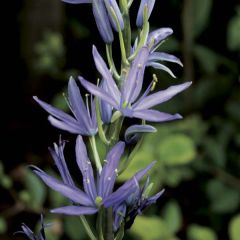
Camassia leichtlinii subsp. suksdorfii Caerulea
- Flowering time May, June
- Height at maturity 80 cm

Camassia leichtlinii Alba
- Flowering time June, July
- Height at maturity 90 cm
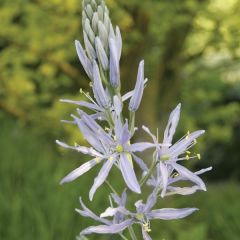
Camassia cusickii
- Flowering time June, July
- Height at maturity 80 cm
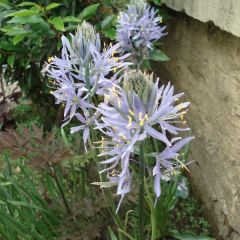
Camassia cusickii Zwanenburg
- Flowering time June, July
- Height at maturity 70 cm
Our favourites:
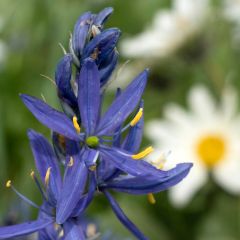
Camassia quamash
- Flowering time June, July
- Height at maturity 60 cm
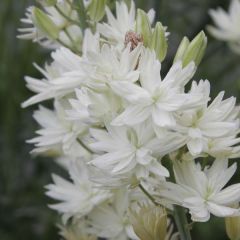
Camassia leichtlinii Semiplena
- Flowering time June, July
- Height at maturity 90 cm
Discover other Camassia
View all →Available in 1 sizes
Available in 1 sizes
Available in 1 sizes
Available in 2 sizes
Available in 1 sizes
Available in 1 sizes
Available in 1 sizes
Available in 1 sizes
Available in 2 sizes
Available in 1 sizes
Planting
When to Plant?
Autumn is the ideal time to plant your Camassia bulbs. Like Tulips and all other bulbs, they will flower the following spring.
If you’re running a bit late, know that it’s still possible to extend the planting window and plant later (until December, as long as the ground isn’t frozen), without any issues.
How to Plant?
To plant your Camassias, simply dig a hole 10 to 15 cm deep, loosen the soil at the bottom, and place the bulb with the pointed end facing upwards. Backfill with soil and firm it down. That’s it—job done!
For a more efficient approach, feel free to watch this video guide:
The bulbs will stay in the ground all winter without any issues—they are very cold-hardy, tolerating temperatures as low as -20°C, even in damp soil.
Where to Plant?
We recommend taking some time to choose the perfect spot in your garden—somewhere you won’t disturb them later, as they really dislike being moved!
Whether in full sun or partial shade, your Camassias will thrive in rich, moist soil and form generous clumps for many years to come.
- In a flowerbed: Pair them with other spring bulbs like tulips, ornamental alliums, and fritillaries—the wide selection will cater to everyone’s tastes and colour preferences. For the best effect, plant them in groups of 4 or 5 bulbs, spacing them about 20 cm apart. Also, mark their location—their foliage is deciduous and disappears in summer, making it easy to forget exactly where they’re planted. It would be a shame to accidentally damage them with a misplaced spade!
- In a meadow: For a natural look, the simplest technique is to take a handful of bulbs and toss them over your shoulder to avoid an overly artificial, lined effect. Plant them where they land, at a rate of about 6 bulbs per square metre. As they naturalise over the years, Camassias will spread to form a stunning spring carpet… To extend this effect, mix different varieties like the Camassia leichtlinii Caerulea, which flowers in April–May when the grass is still short, with the Camassia Quamash, which blooms in May–June alongside buttercups. By late summer, you can mow the meadow—the foliage, essential for replenishing the bulb’s nutrients, will already have died back.
![]()
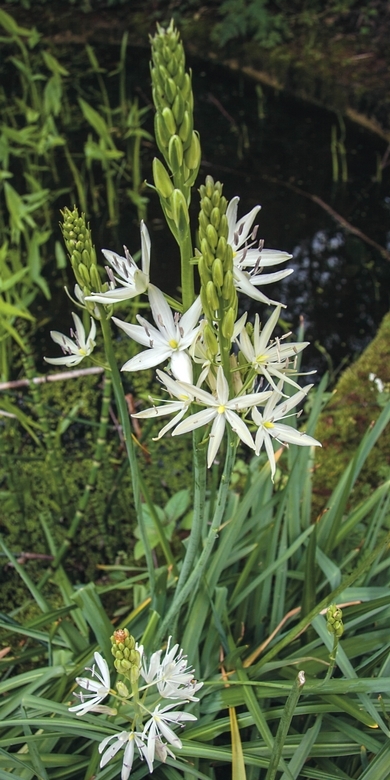
- In a particularly damp area of your garden, such as near a pond, along a stream, or by a spring, Camassias will pair beautifully with marginal plants like marsh marigolds and hostas…
- On a terrace or balcony: Camassias grow very well in pots. To vary and extend flowering throughout spring, choose a large container (50 cm in diameter) and use the lasagne planting technique. This involves planting bulbs in successive layers, each separated by 10 cm of compost: first, line the bottom of the pot with gravel or clay pebbles (about 2 cm deep) for drainage. Then, from bottom to top, layer daffodils, Camassias, tulips, hyacinths, and finally muscari or crocuses, topping with a final layer of compost.
Maintenance
Hardy, long-lasting and maintenance-free, Camassias are definitely easy-going! They are neither prone to disease nor pests. Their bulbs are generally ignored by rodents who find them too tough for their teeth. As for gastropods, there’s nothing to fear or almost nothing: slugs and snails don’t particularly fancy their foliage. Excellent news, isn’t it?
Maintenance is minimal: in flower beds, you can remove spent flowers, which will prevent seed formation that tends to exhaust the bulbs. But don’t cut back the foliage, as it’s what allows the plant to replenish its nutrient reserves. Wait until summer when it’s completely dry – this signals the plant’s dormant period.
Camassia bulbs can, of course, remain in the ground throughout winter; they are very hardy, resilient and unfazed by frost even in damp soil.
Propagation
There are two methods for propagating Camassia: sowing and division.
Sowing
Sowing Camassia is possible, but it’s a bit lengthy and complicated. Indeed, the seeds require a period of cold stratification to break dormancy, an essential step for germination. This dormancy is a resting period that allows the seed to wait for spring without exhausting itself. During winter, the cold gradually weakens the seed coat (this is stratification), and by early spring, germination becomes possible. You can artificially recreate this cold period by storing your patiently harvested seeds in the refrigerator.
Sow them in spring, and if all goes well, seedlings will develop. Then, you’ll just need to wait 4 to 5 years before the first flowering!
In the garden, you may sometimes spot spontaneous seedlings—don’t overcomplicate things, let nature take its course…
Division
Division is the quickest, easiest, and most effective method for propagating Camassia. Dividing clumps is best done in summer, before the foliage disappears, as it’s easier to locate them. Choose well-established plants, at least three years old.
Indeed, like tulips or daffodils, each Camassia bulb produces bulbils, which grow into new bulbs. They will develop leaves in turn and flower after a few years.
You can simply split the clump in two or carefully separate each bulb and replant them one by one.
Planting new bulbs is undoubtedly the quickest and most effective method. It also offers the advantage of introducing new varieties to your garden.
Association
Camassias are incredibly easy to pair with other plants. There’s no risk of clashing colours – their white or varying shades of blue effortlessly complement red, yellow, or even orange for a vibrant, energising effect!
The only factor to consider is the height of their flower spikes, which depending on the variety can range from 60cm up to 1.3 metres.
Here are some inspiring pairing suggestions:
In flower beds, plant your Camassias alongside other spring bulbs: Tulips, Ornamental Alliums, Fritillaries, Daffodils… The possibilities are endless and can change each year according to your preferences.
Arrange your Camassias among perennial borders: Hostas, Geraniums, Ferns, and Heucheras have the advantage of concealing the Camassias’ foliage, which – like that of Daffodils – becomes rather unremarkable once flowering has finished.
Pair your Camassias with Astrantias: these two plants thrive in similar conditions (rich, moist soil in partial shade). Alternatively, plant them at the base of a rose bush alongside Delphiniums and Campanulas that will take over later in the season, just like in beautiful English cottage gardens.
Plant your Camassias beneath purple-leaved shrubs like Japanese Maples or Smoke Bushes – they’ll create a highly ornamental foreground.
Along stream banks or in damp areas of your garden, try combining them with moisture-loving companions: Hostas, Candelabra Primroses, Ferns…
For striking visual impact, place a pot of Camassias on your patio against an attractive wall… This way you can fully appreciate every delicate detail of their flowers.
Most importantly, plant your Camassias to create a stunning wildflower meadow – their natural habitat. Their spring blooms will enchant you, and they’ll naturalise beautifully over time.
Finally, it’s worth noting that Camassias reign supreme in English gardens. At the 2015 Chelsea Flower Show, Chris Beardshaw showcased them particularly brilliantly. For inspiration, here’s the plan of this magnificent creation and the list of companion plants (in Latin).
- Subscribe!
- Contents
